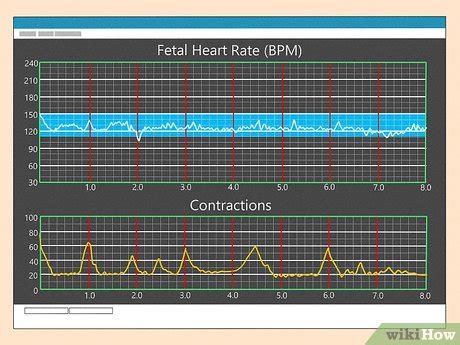Understanding how to read a contraction monitor is crucial for pregnant women, especially those who are nearing their due date or are experiencing preterm labor. A contraction monitor, also known as a fetal monitoring strip, is a tool used by healthcare providers to track the frequency, duration, and intensity of uterine contractions during pregnancy and labor. Here’s a comprehensive guide on how to read a contraction monitor:
Introduction to Contraction Monitoring
Contraction monitoring is a method used to assess the well-being of the fetus and the progression of labor. It involves attaching sensors to the mother’s abdomen to track fetal heart rate and uterine contractions. The information is then displayed on a monitor and printed out on a strip of paper, known as a fetal monitoring strip.
Components of a Contraction Monitor
A typical contraction monitor displays several key pieces of information: - Fetal Heart Rate (FHR): The top line on the monitor usually shows the fetal heart rate, measured in beats per minute (bpm). A normal fetal heart rate ranges from 110 to 160 bpm. - Uterine Contractions: The bottom line on the monitor displays uterine contractions. Contractions are measured in terms of their frequency (how often they occur), duration (how long they last), and intensity (how strong they are). - Baseline FHR: This is the average fetal heart rate when the fetus is at rest. - Variability: This refers to the fluctuations in the fetal heart rate that occur due to the fetal heart’s natural rhythm. It is an indicator of fetal well-being. - Accelerations and Decelerations: Accelerations are increases in the fetal heart rate, often seen as a response to fetal movement. Decelerations are decreases in the fetal heart rate, which can be early (uniform and mirror the shape of the contraction), late (start after the contraction begins and return to baseline after it ends), or variable (vary in timing and appearance).
How to Interpret Contraction Patterns
Interpreting contraction patterns involves understanding the frequency, duration, and intensity of contractions, as well as their effect on fetal heart rate. - Frequency: Measured from the beginning of one contraction to the beginning of the next. In active labor, contractions typically occur every 2-3 minutes. - Duration: The length of time a contraction lasts, usually measured in seconds. Contractions in active labor can last anywhere from 30 to 70 seconds. - Intensity: This is more subjective and can be felt by the mother or measured through internal monitoring devices. It’s an indicator of how strong the contractions are.
Understanding the Significance of Patterns
- Normal Patterns: Regular, moderate contractions with a normal fetal heart rate pattern are generally a good sign.
- Abnormal Patterns: Frequent, intense, or prolonged contractions, or those associated with abnormal fetal heart rate patterns, may indicate potential issues such as fetal distress or uterine hyperstimulation.
Using Contraction Monitoring in Decision Making
Healthcare providers use the information from contraction monitoring to assess labor progress, fetal well-being, and to guide decisions regarding interventions or the need for closer surveillance. For example, if contractions are very frequent or intense, and the fetus is showing signs of distress, the healthcare provider might decide to intervene to reduce the intensity of contractions or to expedite delivery.
Conclusion
Reading a contraction monitor requires understanding the different components displayed and how they relate to labor progress and fetal well-being. While the technical aspects of interpretation are best left to healthcare professionals, having a basic understanding can empower pregnant women and their families to be more engaged in the labor process.
FAQ Section
What is the purpose of a contraction monitor during labor?
+The primary purpose of a contraction monitor is to track the frequency, duration, and intensity of uterine contractions and monitor the fetal heart rate in real-time, ensuring the well-being of both the mother and the fetus during labor.
How often should contractions occur during active labor?
+During active labor, contractions typically occur every 2-3 minutes. However, the frequency can vary from woman to woman and even throughout the labor process.
What does it mean if a contraction is intense?
+An intense contraction refers to one that is particularly strong. Intensity can be subjective, felt by the mother, or measured through internal monitoring devices. Very intense contractions can sometimes indicate the need for medical intervention to ensure the comfort and safety of both the mother and the fetus.
Why is fetal heart rate monitoring important during labor?
+Fetal heart rate monitoring is crucial because it provides real-time feedback on how the fetus is tolerating labor. Abnormal patterns can indicate fetal distress, allowing healthcare providers to intervene promptly to ensure the best possible outcomes.
Can I use a contraction monitor at home?
+While there are devices available for home use that can track contractions, these are generally not as sophisticated as the monitors used in medical settings. For accurate and safe monitoring, especially during active labor, it’s recommended to be in a healthcare facility under the supervision of qualified professionals.



